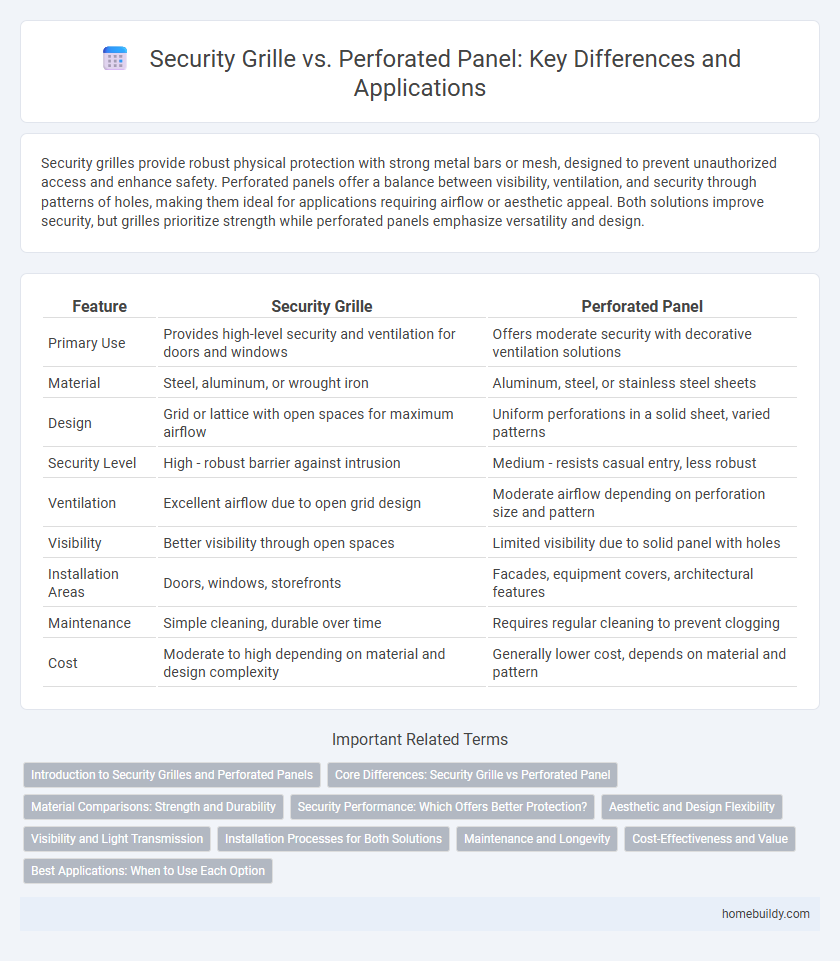Security grilles provide robust physical protection with strong metal bars or mesh, designed to prevent unauthorized access and enhance safety. Perforated panels offer a balance between visibility, ventilation, and security through patterns of holes, making them ideal for applications requiring airflow or aesthetic appeal. Both solutions improve security, but grilles prioritize strength while perforated panels emphasize versatility and design.
Table of Comparison
| Feature | Security Grille | Perforated Panel |
|---|---|---|
| Primary Use | Provides high-level security and ventilation for doors and windows | Offers moderate security with decorative ventilation solutions |
| Material | Steel, aluminum, or wrought iron | Aluminum, steel, or stainless steel sheets |
| Design | Grid or lattice with open spaces for maximum airflow | Uniform perforations in a solid sheet, varied patterns |
| Security Level | High - robust barrier against intrusion | Medium - resists casual entry, less robust |
| Ventilation | Excellent airflow due to open grid design | Moderate airflow depending on perforation size and pattern |
| Visibility | Better visibility through open spaces | Limited visibility due to solid panel with holes |
| Installation Areas | Doors, windows, storefronts | Facades, equipment covers, architectural features |
| Maintenance | Simple cleaning, durable over time | Requires regular cleaning to prevent clogging |
| Cost | Moderate to high depending on material and design complexity | Generally lower cost, depends on material and pattern |
Introduction to Security Grilles and Perforated Panels
Security grilles consist of interlocking metal bars designed to provide high-level protection while allowing visibility and airflow, commonly used in storefronts and secure facilities. Perforated panels are flat metal sheets with a pattern of holes that offer ventilation and aesthetic appeal but typically provide less physical security compared to security grilles. Both solutions balance security and airflow, yet security grilles prioritize robust defense against intrusion whereas perforated panels emphasize design flexibility and partial barrier functionality.
Core Differences: Security Grille vs Perforated Panel
Security grilles feature robust metal bars arranged in a grid pattern, providing high-level physical security and visibility, while perforated panels consist of metal sheets with uniformly spaced holes, offering moderate security with ventilation and aesthetic appeal. Security grilles are ideal for safeguarding entrances and storefronts against forced entry, whereas perforated panels excel in applications requiring airflow, noise reduction, and partial visibility. The core difference lies in security strength and functionality, with grilles prioritizing protection and perforated panels emphasizing ventilation and design versatility.
Material Comparisons: Strength and Durability
Security grilles are typically constructed from heavy-duty metals such as steel or aluminum, offering superior strength and impact resistance compared to perforated panels, which are often made from thinner sheet metals. The robustness of security grilles ensures enhanced durability in high-traffic or vulnerable areas, providing long-term protection against forced entry. Perforated panels, while lighter and more versatile for design, generally lack the structural integrity to withstand aggressive physical impact, making security grilles the preferred choice for maximum security applications.
Security Performance: Which Offers Better Protection?
Security grilles provide superior protection with their robust metal bars designed to deter forced entry and withstand heavy impact, making them ideal for high-security applications. Perforated panels, while offering some visibility and ventilation benefits, typically feature thinner material and larger openings that may be more vulnerable to cutting or penetration. For maximum security performance, metal security grilles offer enhanced resistance against break-ins compared to perforated panels.
Aesthetic and Design Flexibility
Security grilles offer greater design flexibility with customizable patterns and materials that enhance aesthetic appeal while maintaining high security levels. In contrast, perforated panels provide uniform, industrial looks with limited customization options, often prioritizing ventilation over visual design. Choosing security grilles allows architects and designers to create visually striking, secure spaces without compromising on style.
Visibility and Light Transmission
Security grilles offer superior visibility and light transmission compared to perforated panels due to their open, lattice-like design that maximizes airflow and sightlines. Perforated panels, with their smaller, regularly spaced holes, tend to restrict light and visibility more significantly while still providing reasonable security. Choosing between these options depends on the balance required between transparency, natural light, and protection in a given environment.
Installation Processes for Both Solutions
Security grilles require precise measurement and secure mounting to ensure maximum protection, often involving the installation of heavy-duty frames and locking mechanisms. Perforated panels are typically easier to install, as they involve screwing or riveting lightweight sheets onto existing structures, offering quicker deployment with less structural modification. Both solutions demand accurate alignment, but perforated panels generally offer more flexibility in retrofit applications due to their simpler installation process.
Maintenance and Longevity
Security grilles require minimal maintenance due to their durable materials and simple design, offering long-lasting protection against intrusions. Perforated panels, while aesthetically versatile, can accumulate debris in the holes, necessitating more frequent cleaning and maintenance. The robust construction of security grilles typically results in greater longevity compared to perforated panels, making them a cost-effective security solution.
Cost-Effectiveness and Value
Security grilles typically offer greater cost-effectiveness than perforated panels due to their durable materials and simpler installation process, which reduces labor expenses. The robust construction of security grilles provides enhanced value through long-term protection against intrusions and vandalism, minimizing maintenance and replacement costs. Perforated panels, while offering aesthetic appeal, often incur higher upfront costs and may require more frequent upkeep, reducing their overall value compared to security grilles in high-security applications.
Best Applications: When to Use Each Option
Security grilles offer maximum protection and visibility, ideal for high-risk areas such as storefronts and parking garages where burglary prevention and airflow are critical. Perforated panels suit applications requiring a balance of aesthetics, moderate security, and ventilation, like office partitions or decorative facades. Choose security grilles for heavy-duty security needs and perforated panels for lightweight, design-focused solutions with ventilation benefits.
Security grille vs Perforated panel Infographic

 homebuildy.com
homebuildy.com